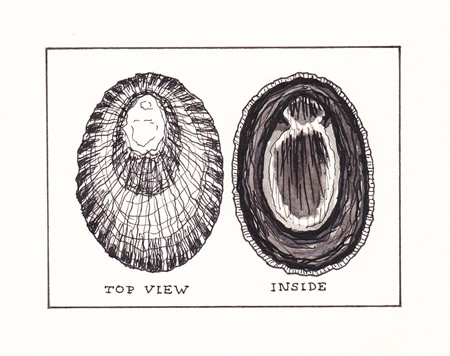
So named because the inside of the empty shell is glossy and colored with a dark and light silhouette that is supposed to resemble an owl, the Owl Limpet (Lottia gigantea) is the largest member of the order patellogastropoda, the true limpet group found in North America. A mollusk that is found in the mid to high intertidal zone, it lives on rocks exposed to the surf. Having a range from northern California to Baja California, this gastropod is most abundantly found in its southern range, which includes Laguna Beach.
Belonging to the mollusk family, the Owl Limpet has a single low-profile elongated conical shell with an off-center peak and a muscular foot on the underside of the body. Although the outside of the shell is naturally speckled dark brown and white, because of the scouring of the waves, the shell is usually eroded to shades of white, brown and black and shows a pattern of concentric growth rings. The top of the muscular foot is light gray and the underside is yellow or pale orange. Averaging in size from 1½ to 2½ inches, the shell can reach four inches in length and has been known to live to be 20 years of age.

The Owl Limpet reproduces once a year in late fall or early winter by broadcast spawning and the larva can travel long distances before landing in an intertidal zone. Hermaphrodites, all limpets start their life as males. As they grow in age and size, some are transformed into females. Nighttime herbivores, the Owl Limpet uses a rasping tongue located on its underside, as it grazes on sea lettuce and other algae on the rocks. The female limpet maintains a grazing territory of about one square foot that she protects by bulldozing other limpets, sea anemones, mussels, barnacles and other species of intruders. In addition, the limpet also uses its tongue to make a home scar, which is a depression within its territory that conforms to the size and shape of its shell and that is enlarged as the limpet grows. This is where they return to after feeding and it helps protect the limpet from predators and the forces of wave action as well as drying out from exposure to sun, air and heat during low tide.
Because the Owl Limpet adheres to the rocks so well, predation is limited mainly to the black oystercatcher and man. Sometimes called the “poor mans abalone,” archaeological research has revealed that the Owl Limpet has been a food and fishing-bait source for over 10,000 years and some are still legally harvested recreationally in certain areas and illegally poached in marine protected areas. Generally preferring larger, thus female individuals, the selective pressure from human harvesting has been found to impact the average size and age, thus diminishing the reproductive abilities of the mollusk. Today, populations are dominated by younger, smaller males. These changes are of concern to scientists and environmentalists, and it is hoped that active protection will allow the Owl Limpet to return to its historic levels.
Laguna Beach residents and ocean swimmers Mia Davidson and Jan Sattler remind beachgoers they are prohibited from possessing or disturbing marine animal or plant life.




